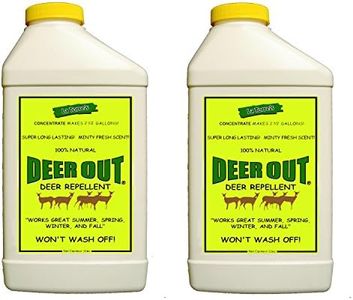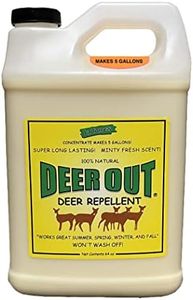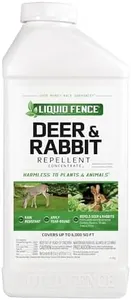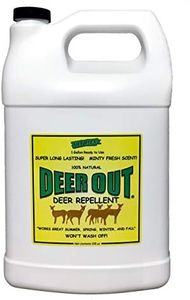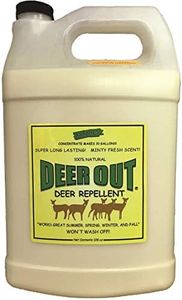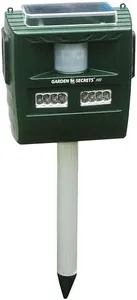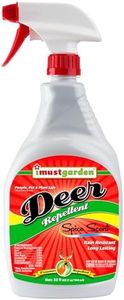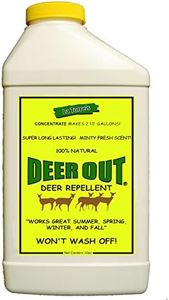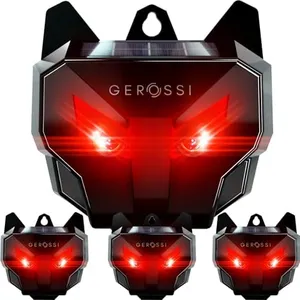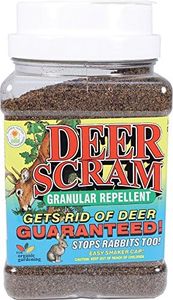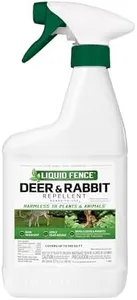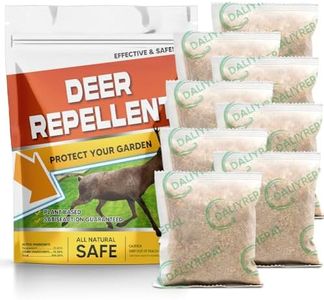We Use CookiesWe use cookies to enhance the security, performance,
functionality and for analytical and promotional activities. By continuing to browse this site you
are agreeing to our privacy policy
10 Best Deer Repellents
From leading brands and best sellers available on the web.Buying Guide for the Best Deer Repellents
Choosing a deer repellent can be important for protecting your garden, fruits, flowers, or landscaping from curious and hungry deer. Different types of repellents work in different ways, and the best choice depends on your specific environment, the size of the area you want to protect, and how persistent the deer in your area are. Understanding the key specifications of deer repellents will help you select an option that fits your needs and is easy for you to use and maintain.Type (Spray, Granule, Electronic, Physical Barrier)Type refers to the main form that the repellent takes. Sprays are liquids applied directly to plants or nearby surfaces; they deter deer with scent or taste. Granules are small particles sprinkled around the area; these mainly work through scent. Electronic repellents use motion sensors and emit lights, sounds, or small bursts of water to scare deer away. Physical barriers include fencing or netting that blocks deer physically. Choosing the right type depends on your preference for convenience, the size of your area, and whether you want a temporary or long-term solution. For large areas, granules or electronic options might be easier, while for prized individual plants, sprays or barriers can offer more focused protection.
Active IngredientThe active ingredient is what makes the repellent work. Common ingredients include putrescent egg solids, garlic, capsaicin (from hot peppers), and predator urine. These ingredients repel deer either because they smell or taste unpleasant or suggest danger. Putrescent egg and garlic-based products tend to be long-lasting and less likely to harm plants. Capsaicin-based repellents offer strong taste-based deterrence but must be applied with care around edible plants. Predator urine mimics the presence of natural threats but may need frequent reapplication. Consider your comfort with scents, safety for pets or children, and whether you'll use the product near food crops to pick the best active ingredient.
Longevity (Duration of Effectiveness)Longevity describes how often you need to reapply the repellent for continuous protection. Some products last for a few days, while others can persist for weeks, depending on weather and exposure. Shorter-lasting options may require reapplication after rain or watering. Longer-lasting repellents are more convenient for busy users or larger gardens but may cost more. If you have time to regularly maintain your garden, a short-duration product can work fine; if you are often away or want less upkeep, look for repellents with extended protection.
Coverage AreaCoverage area tells you how much ground or how many plants one package of repellent can protect. This is usually listed in square feet or number of plants. Smaller quantities are good for targeting problem spots, while larger packages or bulk products are better for protecting wide landscapes. Consider the size of your garden or yard, and always check the label to ensure you buy enough product to provide full coverage.
Safety for Humans, Pets, and WildlifeSafety is about whether the repellent poses any risk to people, animals, or the surrounding environment. Some repellents, especially those with natural ingredients, are generally safe, while others might irritate skin or be toxic if ingested. Always read the product information. If you have pets, children, or frequent visitors, prioritize products clearly marked as child- and pet-safe. If your garden attracts birds, bees, or other wildlife you want to protect, look for eco-friendly formulas.
Weather ResistanceWeather resistance refers to how well a repellent stands up to rain, sunlight, and temperature changes. Some repellents wash off easily with rain or irrigation and must be reapplied. Others are formulated to resist weather for longer periods. If you live in an area with frequent rain or you use sprinklers often, choose a product described as rain-resistant or weatherproof to minimize how often you'll need to re-treat your plants.
Application MethodThis refers to how you actually use the repellent—whether you spray it, sprinkle it, hang it, or set up a device. Some people prefer easy-to-use sprays, while others like the hands-off nature of devices or granules. If you have physical limitations or are treating a large area, consider how easy the product is to apply and whether it requires special equipment or protective gear. Your comfort with the process and the physical layout of your garden should guide you here.

